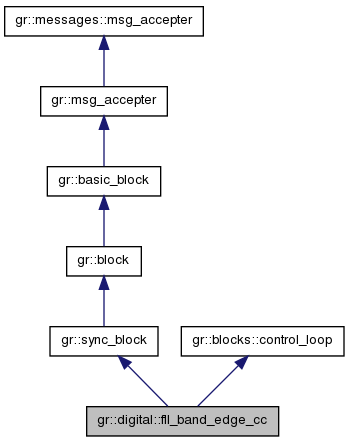Frequency Lock Loop using band-edge filters. More...
#include <fll_band_edge_cc.h>

Public Types | |
| typedef boost::shared_ptr < fll_band_edge_cc > | sptr |
Public Member Functions | |
| virtual void | set_samples_per_symbol (float sps)=0 |
| Set the number of samples per symbol. | |
| virtual void | set_rolloff (float rolloff)=0 |
| Set the rolloff factor of the shaping filter. | |
| virtual void | set_filter_size (int filter_size)=0 |
| Set the number of taps in the filter. | |
| virtual float | samples_per_symbol () const =0 |
| Returns the number of sampler per symbol used for the filter. | |
| virtual float | rolloff () const =0 |
| Returns the rolloff factor used for the filter. | |
| virtual int | filter_size () const =0 |
| Returns the number of taps of the filter. | |
| virtual void | print_taps ()=0 |
Static Public Member Functions | |
| static sptr | make (float samps_per_sym, float rolloff, int filter_size, float bandwidth) |
Detailed Description
Frequency Lock Loop using band-edge filters.
The frequency lock loop derives a band-edge filter that covers the upper and lower bandwidths of a digitally-modulated signal. The bandwidth range is determined by the excess bandwidth (e.g., rolloff factor) of the modulated signal. The placement in frequency of the band-edges is determined by the oversampling ratio (number of samples per symbol) and the excess bandwidth. The size of the filters should be fairly large so as to average over a number of symbols.
The FLL works by filtering the upper and lower band edges into x_u(t) and x_l(t), respectively. These are combined to form cc(t) = x_u(t) + x_l(t) and ss(t) = x_u(t) - x_l(t). Combining these to form the signal e(t) = Re{cc(t) \times ss(t)^*} (where ^* is the complex conjugate) provides an error signal at the DC term that is directly proportional to the carrier frequency. We then make a second-order loop using the error signal that is the running average of e(t).
In practice, the above equation can be simplified by just comparing the absolute value squared of the output of both filters: abs(x_l(t))^2 - abs(x_u(t))^2 = norm(x_l(t)) - norm(x_u(t)).
In theory, the band-edge filter is the derivative of the matched filter in frequency, (H_be(f) = frac{H(f)}{df}). In practice, this comes down to a quarter sine wave at the point of the matched filter's rolloff (if it's a raised-cosine, the derivative of a cosine is a sine). Extend this sine by another quarter wave to make a half wave around the band-edges is equivalent in time to the sum of two sinc functions. The baseband filter fot the band edges is therefore derived from this sum of sincs. The band edge filters are then just the baseband signal modulated to the correct place in frequency. All of these calculations are done in the 'design_filter' function.
Note: We use FIR filters here because the filters have to have a flat phase response over the entire frequency range to allow their comparisons to be valid.
It is very important that the band edge filters be the derivatives of the pulse shaping filter, and that they be linear phase. Otherwise, the variance of the error will be very large.
Member Typedef Documentation
Member Function Documentation
| virtual int gr::digital::fll_band_edge_cc::filter_size | ( | ) | const [pure virtual] |
Returns the number of taps of the filter.
| static sptr gr::digital::fll_band_edge_cc::make | ( | float | samps_per_sym, |
| float | rolloff, | ||
| int | filter_size, | ||
| float | bandwidth | ||
| ) | [static] |
Make an FLL block.
- Parameters:
-
samps_per_sym (float) number of samples per symbol rolloff (float) Rolloff (excess bandwidth) of signal filter filter_size (int) number of filter taps to generate bandwidth (float) Loop bandwidth
| virtual void gr::digital::fll_band_edge_cc::print_taps | ( | ) | [pure virtual] |
Print the taps to screen.
| virtual float gr::digital::fll_band_edge_cc::rolloff | ( | ) | const [pure virtual] |
Returns the rolloff factor used for the filter.
| virtual float gr::digital::fll_band_edge_cc::samples_per_symbol | ( | ) | const [pure virtual] |
Returns the number of sampler per symbol used for the filter.
| virtual void gr::digital::fll_band_edge_cc::set_filter_size | ( | int | filter_size | ) | [pure virtual] |
Set the number of taps in the filter.
This sets the number of taps in the band-edge filters. Setting this will force a recalculation of the filter taps.
This should be about the same number of taps used in the transmitter's shaping filter and also not very large. A large number of taps will result in a large delay between input and frequency estimation, and so will not be as accurate. Between 30 and 70 taps is usual.
- Parameters:
-
filter_size (float) number of taps in the filters
| virtual void gr::digital::fll_band_edge_cc::set_rolloff | ( | float | rolloff | ) | [pure virtual] |
Set the rolloff factor of the shaping filter.
This sets the rolloff factor that is used in the pulse shaping filter and is used to calculate the filter taps. Changing this will force a recalculation of the filter taps.
This should be the same value that is used in the transmitter's pulse shaping filter. It must be between 0 and 1 and is usually between 0.2 and 0.5 (where 0.22 and 0.35 are commonly used values).
- Parameters:
-
rolloff (float) new shaping filter rolloff factor [0,1]
| virtual void gr::digital::fll_band_edge_cc::set_samples_per_symbol | ( | float | sps | ) | [pure virtual] |
Set the number of samples per symbol.
Set's the number of samples per symbol the system should use. This value is uesd to calculate the filter taps and will force a recalculation.
- Parameters:
-
sps (float) new samples per symbol
The documentation for this class was generated from the following file:
